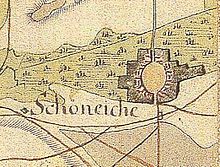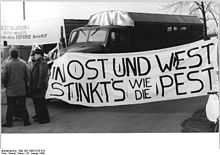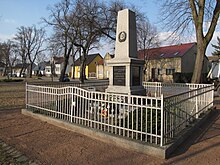Schöneiche (Zossen)
|
Beautiful oak
City of Zossen
Coordinates: 52 ° 13 ′ 25 ″ N , 13 ° 30 ′ 39 ″ E
|
||
|---|---|---|
| Height : | 36 m | |
| Area : | 14.48 km² | |
| Residents : | 565 (Dec. 31, 2006) | |
| Population density : | 39 inhabitants / km² | |
| Incorporation : | October 26, 2003 | |
| Postal code : | 15806 | |
| Area code : | 03377 | |
|
Location of Schöneiche in Brandenburg |
||
Schöneiche is a district of the town of Zossen in the Teltow-Fläming district ( Brandenburg ). Until it was incorporated into the town of Zossen in 2003, Schöneiche was an independent municipality which, when it was first mentioned in documents in 1490, belonged to the Zossen rule , later to the Zossen office .
Geographical location and structure
The original core of Schöneiche is approx. 4.3 km from the center of Zossen. The district borders clockwise in the north and east on the districts of Telz and Gallun (both cities of Mittenwalde ), in the east on the districts of Kallinchen , Töpchin and Waldstadt (all three cities of Zossen ). The original core of the village is a Rundling , which allows certain conclusions about the settlement history. The place has expanded along the L 744 to the northwest and to the southeast and east. The name is of German origin and can be read as "settlement to the beautiful oak". In the vicinity of the oak forester's house there is the field name "old Schöneiche", but it could possibly also be a reference to the original Slavic settlement. In addition, some Slavic field names have been handed down with regard to the Schöneiche district, which also indicate an originally Slavic settlement in the Schöneiche district.
In 1900 the area covered 1386 hectares, in 1931 there were 1406 hectares. The area currently measures 1,448 hectares. During the land reform in Germany in 1945, a few hectares of the former Zossen military training area, which adjoined the area to the south (today part of the municipality of Waldstadt ), were added to the area .
history
Early to the 19th century
During archaeological excavations, three stone axes and several ceramic shards were found. This made it possible to prove that the region was settled from the Neolithic to the Early Bronze Age . Due to the village structure of a Rundling - at least in Wendland - it can be assumed that the Feldmark was created in the 12th century by Slavic and German settlers, possibly even under the pressure or under the influence of a German manor. Rundlinge are therefore a form of rural plan settlement, but not an originally Slavic settlement form.
The place is first mentioned in 1490 as "Schoneiche". Occasionally there is an even earlier first mention of the year 1433 in the literature; However, this is due to incorrect dating of the relevant document (cf. Schlimpert, 1972). At this time Schoeneiche belonged to the rule Zossen, which this year for 16,000 Rhine thalers from Brandenburg Elector Johann Cicero to the family of Altenow invested was. In 1524 the place became the fiefdom of Hans Boß and six years later it became the electoral domain of Zossen. According to the inheritance register of the Zossen office from 1583, the field mark had 17 Hufen which was cultivated by 16 farmers; the Lehnschulze farmed two Hufen. A hoof measured about 9 hectares. There were also ten kossas in the village who cultivated fields from 3.5 to 11.5 acres; these also had meadows and gardens. The Vorwerk zu Zossen had 127 acres of fields under the plow, which were cleared in 1571 "on the old Schoneiche". Since the end of the 16th century, school service or teaching the children has mostly been taken over by the local sexton or tailors. In 1742, after long negotiations , Frederick II gave the village a royal hunter's house, which from then on was used as a school. In 1755 a Schenkkrug was first mentioned in the Schulzengut and in 1801 a forge was mentioned for the first time . It was not until 1803 that trained teachers were used for school lessons. In 1825 the separation of the Schöneich Feldmark began in the course of the replacement of serfdom, which was ended in 1846. In the meantime, there were two major fires each with considerable damage in 1838 and 1839. In 1855 another fire broke out that destroyed a windmill. In 1872/1873 a new schoolhouse was built; In 1892 the male choir "Eintracht" was founded. In the same year Wilhelm Kienbaum sen. an inn on the village meadow.
20th and 21st centuries
As early as 1909, the military training area was laid out east and south-east of Zossen. Parts of the Schöneiche district were also bought by the military treasury and turned into a military training area. In 1914, Albert Puhlmann, another resident, received a bar license, who then ran a restaurant in the Schützenhaus. In 1920 the community erected a memorial on the village meadow to commemorate those who fell from the First World War . The Thiele bakery opened in 1928; In 1933 the volunteer fire brigade was founded. During the Second World War , numerous incendiary bombs were dropped on Schöneiche on January 16, 1943, which destroyed several buildings. Shortly before the end of the war, on April 22, 1945, a total of 21 out of 22 boys aged 15 and 16 died in the Volkssturm .
In 1950 the Schöneiche sports community was founded; seven years later the male choir Eintracht. In 1961 the women's choir Melodie and a fishing club were added. In 1972 the school closed and the children went to school in Zossen. A carnival club was added to the cultural offer in 1980. In 1984 a new kindergarten was opened. In 2003 Schöneiche was incorporated into Zossen. In 2006, the residents celebrated a district harvest festival on September 9th. In 2009 the local bakery closed. In 2012 the volunteer fire brigade erected a new building that also includes several village community rooms. In 2014, the rbb produced a documentation in which editors accompanied some citizens of Schöneich with their work in the courtyards and gardens. Since then, the district has had the addition of "Vitamine Village". In 2018, the district harvest festival took place again in town.
Nice plan
Brickworks
Clay was mined from 1825 on the Schöneicher Plan, an area northeast of the village . In 1860 there were ten brickworks with twelve kilns on the Schöneich plan. During the First World War , brick production came to a standstill and the pits were full of water.
landfill
In the 1920s, workers began filling the pits with garbage from Berlin. From 1974 to 1994 a total of 5 million tons of waste from West Berlin was dumped in the Schöneiche dump. After the fall of the Wall there were protests against these garbage transports due to odor nuisance, so that the transport was switched from open wagons to press container wagons from 1995 onwards. The landfill operation was closed on May 31, 2005 due to the lack of a landfill base seal.
The MEAB (Märkische Entsorgungsanlagen-Betriebsgesellschaft mbH) and the Berliner Stadtreinigung now operate systems for waste processing on the Schöneich Plan.
railroad
The Rixdorf-Mittenwalder Railway built a railway line with the terminus "Schöneicher Plan" in 1903, the main purpose of which was to transport - first of brickwork products in the direction of fast growing Berlin, later of rubbish in the opposite direction.
The railway line was extended to Zossen in 1945, the tracks were dismantled shortly afterwards and relocated again in 1950. Passenger traffic, which was always of minor importance on this route, was discontinued in 1951.
Population development
Population development from 1490 to 2006 see (1490 to 1971 from the historical local dictionary)
| year | Residents |
|---|---|
| 1490 | 100-120 + |
| 1734 | 184 |
| 1772 | 170 |
| 1801 | 219 |
| 1817 | 213 |
| 1840 | 323 |
| 1858 | 412 |
| 1895 | 755 |
| 1925 | 900 |
| 1939 | 867 |
| 1946 | 881 |
| 1964 | 704 |
| 1971 | 670 |
| 2006 | 565 |
+ (17 hooves, 10 hooves)
Monuments and sights
Architectural monuments
The list of monuments of the State of Brandenburg shows a building ensemble in Schöneiche Plan 2 for Schöneiche, consisting of residential house, gate, cowshed with pigeon house, stable building, barn, coach house, dog house, park wall, paving of the courtyard and the two driveways.
Soil monuments
The soil monument list of the state of Brandenburg from 2009 shows five soil monuments for Schöneiche:
- Village center (modern and medieval)
- Rest and work area from the Stone Age, a settlement from prehistory
- Settlement from the Roman imperial era and another prehistoric settlement
- Rest and work area from the Stone Age, medieval settlement
- Settlement of prehistory and early history, medieval field
literature
- Lieselott Enders and Margot Beck: Historical local dictionary for Brandenburg. Part IV. Teltow. 395 p., Hermann Böhlaus successor Weimar, 1976
- Gerhard Schlimpert: Brandenburg name book part 3 The place names of the Teltow. 368 p., Hermann Böhlaus successor, Weimar 1972.
- Wilhelm Spatz: The Teltow. Part T. 3., History of the localities in the Teltow district. 384 pp., Berlin, Rohde, 1912.
Movie
- The Vitamins Village Schöneiche. Documentary, Germany, 2015, 29:40 min., Script and direction: Sylvia Rademacher, production: rbb , series: rbb Gartenzeit special, first broadcast: June 21, 2015 by rbb, summary by rbb, online video available until June 21 2016.
Web links
Individual evidence
- ↑ Main statute of the city of Zossen ( Memento of the original from December 13, 2015 in the Internet Archive ) Info: The archive link was automatically inserted and not yet checked. Please check the original and archive link according to the instructions and then remove this notice. (PDF; 44 kB)
- ↑ a b c Schlimpert (1972: p. 163)
- ↑ Information board : Local history , set up on the village green, October 2018.
- ^ Wolfgang Jürries (ed.): Rundlinge and Slavs, contributions to Rundlingsforschung . Lüchow, 2004, ISBN 3-9806364-0-2
- ↑ a b Enders and Beck (1976: pp. 260–261)
- ↑ Joachim Mielisch: 500 years Schöneiche (1490–1990). Local calendar for the district of Zossen, 1990: 8–10, Zossen 1990
- ↑ Schöneiche garbage dump in the shadow of the wall ( memento from February 11, 2013 in the web archive archive.today ), RBB report from August 4, 2011.
- ↑ Landfill Schöneicher Plan ( Memento of the original from March 3, 2014 in the Internet Archive ) Info: The archive link was inserted automatically and has not yet been checked. Please check the original and archive link according to the instructions and then remove this notice.
- ↑ Process steps of the mechanical-biological waste treatment plant (MBT) of MEAB mbH in Schöneiche
- ↑ Schöneiche industrial estate
- ↑ a b List of monuments of the state of Brandenburg: Teltow-Fläming district (PDF) Brandenburg State Office for Monument Preservation and State Archaeological Museum




